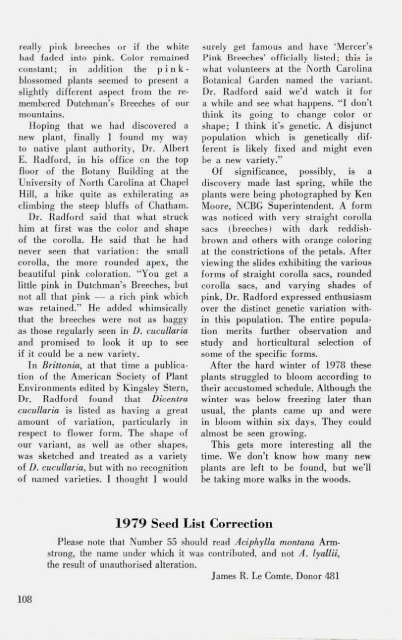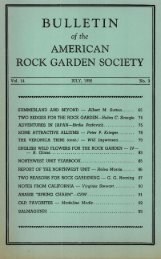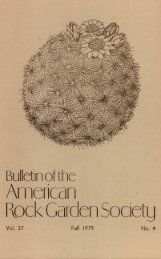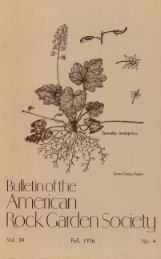Bulletin - Summer 1979 - North American Rock Garden Society
Bulletin - Summer 1979 - North American Rock Garden Society
Bulletin - Summer 1979 - North American Rock Garden Society
You also want an ePaper? Increase the reach of your titles
YUMPU automatically turns print PDFs into web optimized ePapers that Google loves.
eally pink breeches or if the whitehad faded into pink. Color remainedconstant; in addition the pinkblossomedplants seemed to present aslightly different aspect from the rememberedDutchman's Breeches of ourmountains.Hoping that we had discovered anew plant, finally I found my wayto native plant authority, Dr. AlbertE. Radford, in his office on the topfloor of the Botany Building at theUniversity of <strong>North</strong> Carolina at ChapelHill, a hike quite as exhilerating asclimbing the steep bluffs of Chatham.Dr. Radford said that what struckhim at first was the color and shapeof the corolla. He said that he hadnever seen that variation: the smallcorolla, the more rounded apex, thebeautiful pink coloration. "You get alittle pink in Dutchman's Breeches, butnot all that pink — a rich pink whichwas retained." He added whimsicallythat the breeches were not as baggyas those regularly seen in D. cucullariaand promised to look it up to seeif it could be a new variety.In Brittonia, at that time a publicationof the <strong>American</strong> <strong>Society</strong> of PlantEnvironments edited by Kingsley Stern,Dr. Radford found that Dicentracucullaria is listed as having a greatamount of variation, particularly inrespect to flower form. The shape ofour variant, as well as other shapes,was sketched and treated as a varietyof D. cucullaria, but with no recognitionof named varieties. I thought I wouldsurely get famous and have 'Mercer'sPink Breeches' officially listed; this iswhat volunteers at the <strong>North</strong> CarolinaBotanical <strong>Garden</strong> named the variant.Dr. Radford said we'd watch it fora while and see what happens. "I don'tthink its going to change color orshape; I think it's genetic. A disjunctpopulation which is genetically differentis likely fixed and might evenbe a new variety."Of significance, possibly, is adiscovery made last spring, while theplants were being photographed by KenMoore, NCBG Superintendent. A formwas noticed with very straight corollasacs (breeches) with dark reddishbrownand others with orange coloringat the constrictions of the petals. Afterviewing the slides exhibiting the variousforms of straight corolla sacs, roundedcorolla sacs, and varying shades ofpink, Dr. Radford expressed enthusiasmover the distinct genetic variation withinthis population. The entire populationmerits further observation andstudy and horticultural selection ofsome of the specific forms.After the hard winter of 1978 theseplants struggled to bloom according totheir accustomed schedule. Although thewinter was below freezing later thanusual, the plants came up and werein bloom within six days. They couldalmost be seen growing.This gets more interesting all thetime. We don't know how many newplants are left to be found, but we'llbe taking more walks in the woods.<strong>1979</strong> Seed List CorrectionPlease note that Number 55 should read Aciphylla montana Armstrong,the name under which it was contributed, and not A. lyallii,the result of unauthorised alteration.James R. Le Comte, Donor 481108









